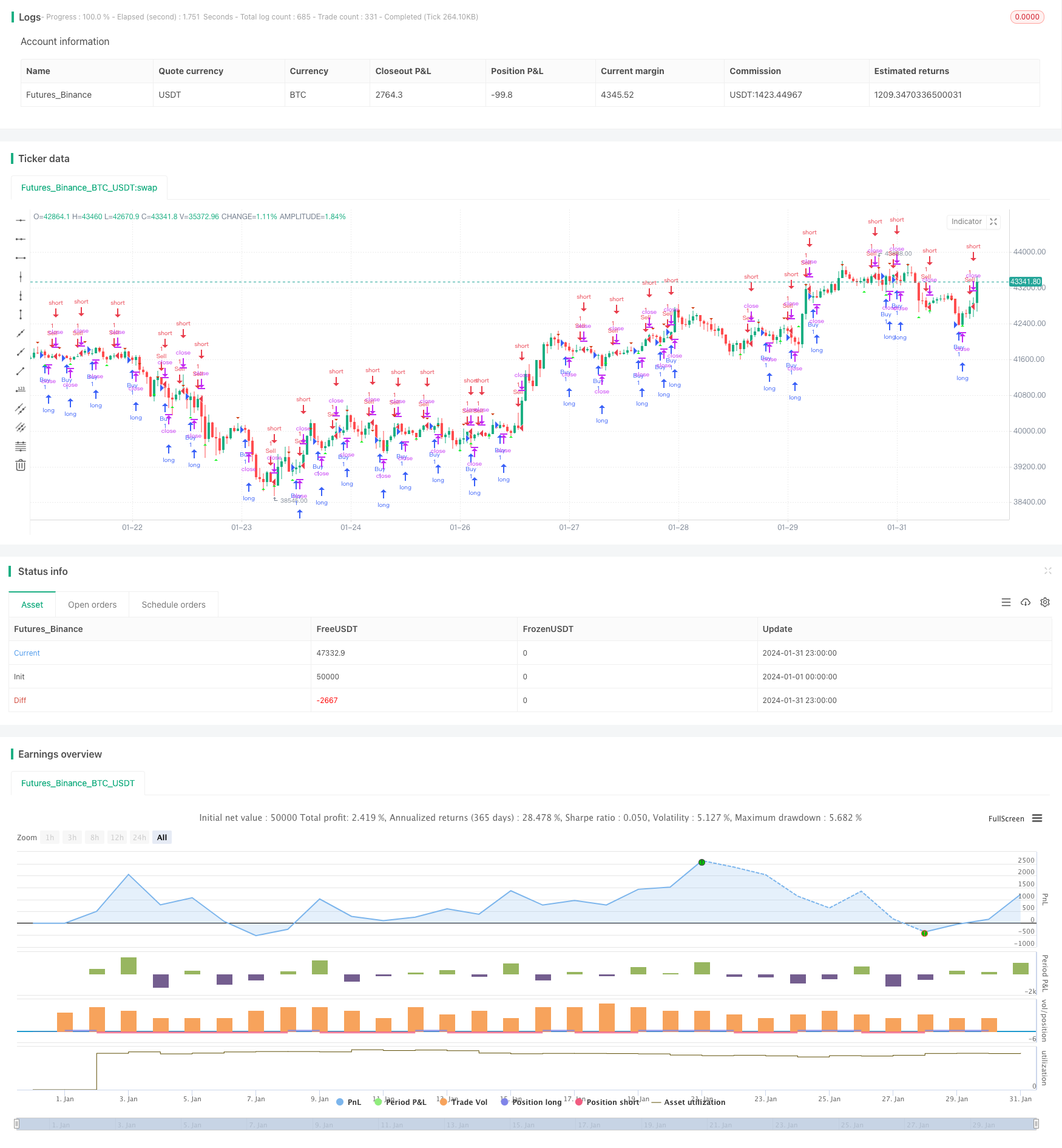
概述
本策略名称为“基于峰峰形态的交易策略”,主要利用K线的峰峰形态来确定买入和卖出时机。该策略属于技术分析类策略。
策略原理
该策略通过定义上升峰值(upFractal)和下降峰值(downFractal)来判断K线图形的峰峰形态。
具体来说,上升峰值的判断逻辑是:当前K线的高点是最近n根K线的最高点,并且后续的K线高点都不超过当前K线的高点。
下降峰值的判断逻辑是:当前K线的低点是最近n根K线的最低点,并且后续的K线低点都不低于当前K线的低点。
这里通过布尔变量及循环来判断前n根和后n根K线与当前K线的高低点关系,最终确定上升峰值和下降峰值。
因此,该策略的核心逻辑就是:
- 判断上升峰值和下降峰值
- 上升峰值时做多,下降峰值时做空
优势分析
该策略具有以下优势:
- 峰峰形态容易识别,操作简单
- 利用技术形态,不受基本面影响
- 回撤可能比较小
风险分析
该策略也存在一些风险:
- 峰峰形态判断不准确,可能错过最佳入场时机
- 行情剧烈变动时,止损可能较难确定
- 只依靠形态,忽略了其他因素
对策:
- 调整峰峰形态的参数,优化判断逻辑
- 结合其他指标确定止损位置
- 与基本面分析或其他策略组合使用
优化方向
该策略还可以从以下几个方向进行优化:
- 增加参数调整空间,优化峰峰形态判断
- 加入止损逻辑
- 考虑交易量或波动率等其他指标
- 结合不同时间周期分析
总结
本策略基于峰峰形态原理简单易操作,回撤可能较小。但也存在一定风险,需要与其他分析方法组合使用才能发挥最大效果。下一步将从判断准确性、止损、指标优化等方面进行改进。
策略源码
/*backtest
start: 2024-01-01 00:00:00
end: 2024-01-31 23:59:59
period: 1h
basePeriod: 15m
exchanges: [{"eid":"Futures_Binance","currency":"BTC_USDT"}]
*/
//@version=5
strategy("sanju parmar", shorttitle="sanju trading empire", overlay=true)
// Define "n" as the number of periods and keep a minimum value of 2 for error handling.
n = input.int(title="Periods", defval=2, minval=2)
// UpFractal
bool upflagDownFrontier = true
bool upflagUpFrontier0 = true
bool upflagUpFrontier1 = true
bool upflagUpFrontier2 = true
bool upflagUpFrontier3 = true
bool upflagUpFrontier4 = true
for i = 1 to n
upflagDownFrontier := upflagDownFrontier and (high[n-i] < high[n])
upflagUpFrontier0 := upflagUpFrontier0 and (high[n+i] < high[n])
upflagUpFrontier1 := upflagUpFrontier1 and (high[n+1] <= high[n] and high[n+i + 1] < high[n])
upflagUpFrontier2 := upflagUpFrontier2 and (high[n+1] <= high[n] and high[n+2] <= high[n] and high[n+i + 2] < high[n])
upflagUpFrontier3 := upflagUpFrontier3 and (high[n+1] <= high[n] and high[n+2] <= high[n] and high[n+3] <= high[n] and high[n+i + 3] < high[n])
upflagUpFrontier4 := upflagUpFrontier4 and (high[n+1] <= high[n] and high[n+2] <= high[n] and high[n+3] <= high[n] and high[n+4] <= high[n] and high[n+i + 4] < high[n])
flagUpFrontier = upflagUpFrontier0 or upflagUpFrontier1 or upflagUpFrontier2 or upflagUpFrontier3 or upflagUpFrontier4
upFractal = (upflagDownFrontier and flagUpFrontier)
// downFractal
bool downflagDownFrontier = true
bool downflagUpFrontier0 = true
bool downflagUpFrontier1 = true
bool downflagUpFrontier2 = true
bool downflagUpFrontier3 = true
bool downflagUpFrontier4 = true
for i = 1 to n
downflagDownFrontier := downflagDownFrontier and (low[n-i] > low[n])
downflagUpFrontier0 := downflagUpFrontier0 and (low[n+i] > low[n])
downflagUpFrontier1 := downflagUpFrontier1 and (low[n+1] >= low[n] and low[n+i + 1] > low[n])
downflagUpFrontier2 := downflagUpFrontier2 and (low[n+1] >= low[n] and low[n+2] >= low[n] and low[n+i + 2] > low[n])
downflagUpFrontier3 := downflagUpFrontier3 and (low[n+1] >= low[n] and low[n+2] >= low[n] and low[n+3] >= low[n] and low[n+i + 3] > low[n])
downflagUpFrontier4 := downflagUpFrontier4 and (low[n+1] >= low[n] and low[n+2] >= low[n] and low[n+3] >= low[n] and low[n+4] >= low[n] and low[n+i + 4] > low[n])
flagDownFrontier = downflagUpFrontier0 or downflagUpFrontier1 or downflagUpFrontier2 or downflagUpFrontier3 or downflagUpFrontier4
downFractal = (downflagDownFrontier and flagDownFrontier)
plotshape(downFractal, style=shape.triangleup, location=location.belowbar, offset=-n, color=#18f523, size = size.small)
plotshape(upFractal, style=shape.triangledown, location=location.abovebar, offset=-n, color=#cf3d11, size = size.small)
// Strategy Conditions
longCondition = upFractal
shortCondition = downFractal
// Strategy Entry and Exit
if (longCondition)
strategy.entry("Buy", strategy.long)
if (shortCondition)
strategy.entry("Sell", strategy.short)